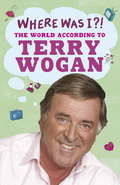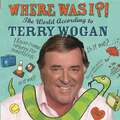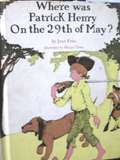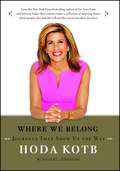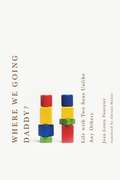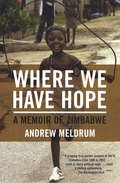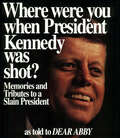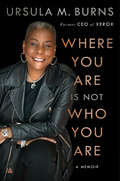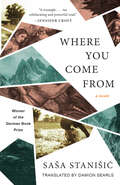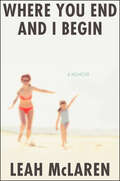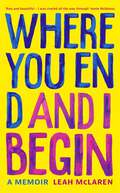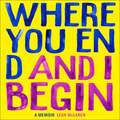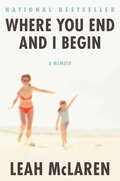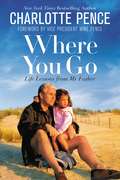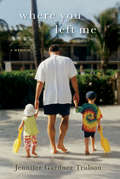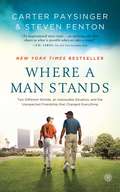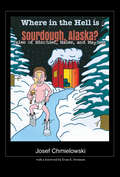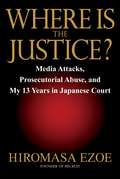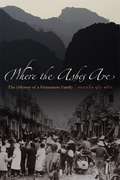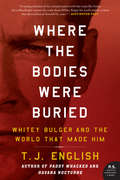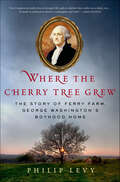- Table View
- List View
Where Was I?!: The World According To Wogan
by Terry WoganUnadulterated Wogan - the voice of sanity in a world gone gently mad.Until recently, eight million people improved their mornings by tuning into Terry's words of wisdom on Wake up to Wogan. But was their appetite sated by this daily exposure? Not in the slightest. So it's lucky that Terry has been known to turn his hand to the odd bit of writing. This has allowed him to shed light on such weighty matters as how to survive a wedding, what Bank Holidays are for, why Eurovision could be responsible for the Celtic Tiger, whether we should watch out for potatoes, and where exactly it all went pear-shaped... WHERE WAS I? gives his devoted followers exactly what they want - the unadulterated, inimitable Wogan viewpoint; a droll, forthright voice of sanity in a world gone gently mad (or is it them?). Like his broadcasting, his writing is an effortless flow of easy wit and sage opinion. WHERE WAS I? builds up a picture not only of Terry's world, but of Terry himself - a man who somehow manages to be off the wall and on the money all at the same time.
Where Was I?!: The World According to Wogan
by Sir Terry Wogan OBEUnadulterated Wogan - the voice of sanity in a world gone gently mad.Until recently, eight million people improved their mornings by tuning into Terry's words of wisdom on Wake up to Wogan. But was their appetite sated by this daily exposure? Not in the slightest. So it's lucky that Terry has been known to turn his hand to the odd bit of writing. This has allowed him to shed light on such weighty matters as how to survive a wedding, what Bank Holidays are for, why Eurovision could be responsible for the Celtic Tiger, whether we should watch out for potatoes, and where exactly it all went pear-shaped... WHERE WAS I? gives his devoted followers exactly what they want - the unadulterated, inimitable Wogan viewpoint; a droll, forthright voice of sanity in a world gone gently mad (or is it them?). Like his broadcasting, his writing is an effortless flow of easy wit and sage opinion. WHERE WAS I? builds up a picture not only of Terry's world, but of Terry himself - a man who somehow manages to be off the wall and on the money all at the same time.
Where Was I?!: The World According to Wogan
by Sir Terry Wogan OBEEight million people improve their mornings by tuning into Terry's words of wisdom on Wake up to Wogan. But is their appetite sated by this daily exposure? Not in the slightest. So it's lucky that Terry has been known to turn his hand to the odd bit of writing. This has allowed him to shed light on such weighty matters as how to survive a wedding, what Bank Holidays are for, why Eurovision could be responsible for the Celtic Tiger, whether we should watch out for potatoes, and where exactly it all went pear-shaped ... WHERE WAS I? gives his devoted followers exactly what they want - the unadulterated, inimitable Wogan viewpoint; a droll, forthright voice of sanity in a world gone gently mad (or is it them?). Like his broadcasting, his writing is an effortless flow of easy wit and sage opinion. WHERE WAS I? builds up a picture not only of Terry's world, but of Terry himself - a man who somehow manages to be off the wall and on the money all at the same time. Never less than funny, and never less than frank, WHERE WAS I? demonstrates exactly how he has come to be regarded as a national treasure.(p) 2009 Orion Publishing Group
Where Was Patrick Henry on the 29th of May?
by Jean FritzWhere was Patrick Henry on the 29th of May? Languishing on a sack of salt in his country store? On the floor of the House of Burgesses speaking against England's stamp tax? In the green Virginia woods fishing and imitating birdsongs? At the royal governor's palace being elected governor? The truth is that all his life as planter, lawyer, statesman, things seemed to happen to Patrick Henry on the 29th of May. And no matter where he was he might be orating. Patrick Henry had a good ear (he even taught himself to play the flute when he was stuck indoors with a broken collar bone) and what people called a "sending voice." What he cared most for was his native Virginia and her freedom. Jean Fritz' keen eye for humorous and humanizing detail, her insight into the Revolution, and her unconventional approach make for a revealing and colorful portrait of Patrick Henry --from practical joker to passionate Virginian.
Where We Belong: Journeys That Show Us The Way
by Hoda KotbFrom New York Times bestselling author and beloved Today show coanchor Hoda Kotb, an &“inspirational page-turner&” (Daily News, New York) about people who find their life&’s purpose in unexpected ways, often surprising themselves and their loved ones.Are you where you belong? Many of us wonder. We float around in the half-empty glass, gaze out into the world of possibilities, and wonder if we should get off our raft and climb out. Maybe even today you asked yourself: Is it too late to do that thing that made me so happy when I was young? Could what matters most to me finally be the center of my life? Can I really trust this yearning voice in my head and longing in my heart? In Where We Belong, Hoda Kotb explores the challenging journeys of people who found their true calling in life by following their passions, their gut, and their heart. The compelling stories include an investment banker who became a minister after years of working on Wall Street, a young woman from a blue-collar background whose passion took her to Harvard Medical School, a high-powered PR executive who was drawn to a unique close-knit community, and a once “no-kids” guy who now helps children all over the world. Hoda also interviews celebrities, such as producer Mark Burnett and actress/producer Roma Downey, comedienne Margaret Cho, and former boxer Laila Ali, all who’ve pursued their passions to fulfill their dreams. The stories told provide examples of perseverance, self-reflection, and new attitudes on life making Where We Belong a motivating guide to finding the right path for your personal journey.
Where We Going, Daddy?
by Adriana Hunter Jean-Louis FournierJean-Louis Fournier did not expect to have a disabled child. He certainly did not expect to have two. But that is precisely what happened to this wry French humorist, and his attempts to live and cope with his Mathieu and Thomas, both facing extremely debilitating physical and mental challenges, is the subject of this brave and heartbreaking book. Fournier recalls the life he imagined having with his sons--but his boys will never really grow up, and he mourns the loss of every memory he thought he'd have. Though a devoted father, he does not shy away from exploring the limits of his love, the countless times he is filled with frustration and disappointment with no relief in sight. Mathieu and Thomas can barely communicate, and each in turn repeats learned phrases, such as "Where we going, Daddy?" (a favorite in the car) in what feels toFournier to be an eternal loop. In WhereWe Going, Daddy? Fournier reveals everything, and that is perhaps his most remarkable quality. He does not hide behind a mask of cliché, but gives voice to the darkness that comes with disability, and the rare moments of light. Through short, powerful vignettes Jean-Louis manages his grief with cynicism and humor. For parents of disabled children, this book will offer some relief from the courage they must garner every day, a chance to let down their guard, laugh at themselves, and embrace even the ugly emotions they feel. For the rest of us, it's an unsettling and heartfelt glimpse into an otherwise unimaginable life.
Where We Going, Daddy?: Life with Two Sons Unlike Any Others
by Jean-Louis FournierJean-Louis Fournier did not expect to have a disabled child. He certainly did not expect to have two. But that is precisely what happened to this wry French humorist, and his attempts to live and cope with his Mathieu and Thomas, both facing extremely debilitating physical and mental challenges, is the subject of this brave and heartbreaking book. Fournier recalls the life he imagined having with his sons-but his boys will never really grow up, and he mourns the loss of every memory he thought he’d have. Though a devoted father, he does not shy away from exploring the limits of his love, the countless times he is filled with frustration and disappointment with no relief in sight. Mathieu and Thomas can barely communicate, and each in turn repeats learned phrases, such as “Where we going, Daddy?” (a favorite in the car) in what feels to Fournier to be an eternal loop. InWhereWe Going, Daddy?Fournier reveals everything, and that is perhaps his most remarkable quality. He does not hide behind a mask of clicheacute;, but gives voice to the darkness that comes with disability, and the rare moments of light. Through short, powerful vignettes Jean-Louis manages his grief with cynicism and humor. For parents of disabled children, this book will offer some relief from the courage they must garner every day, a chance to let down their guard, laugh at themselves, and embrace even the ugly emotions they feel. For the rest of us, it’s an unsettling and heartfelt glimpse into an otherwise unimaginable life.
Where We Have Hope: A Memoir of Zimbabwe
by Andrew MeldrumWhere We Have Hope is the gripping memoir of a young American journalist. In 1980, Andrew Meldrum arrived in a Zimbabwe flush with new independence, and he fell in love with the country and its optimism. But over the twenty years he lived there, Meldrum watched as President Robert Mugabe consolidated power and the government evolved into despotism. In May 2003, Meldrum, the last foreign journalist still working in the dangerous and chaotic nation, was illegally forced to leave his adopted home. His unflinching work describes the terror and intimidation Mugabe’s government exercised on both the press and citizens, and the resiliency of Zimbabweans determined to overturn Mugabe and demand the free society they were promised.
Where Were You When President Kennedy Was Shot?: Memories and Tributes to a Slain President
by Abigail Van BurenFrom the readers of Dear Abby, America’s iconic advice columnist, remembrances and testimonials from the historic day in 1963 when JFK was assassinated. In October 1992, Dear Abby asked her readers, “Where were you when President Kennedy was shot?” More than 300,000 people took the trouble to respond. While several responses were published in December 1992, it became obvious that no single column could do justice to that question.In letters and postcards from all over the world, ordinary people described memories that were fascinating, ironic, poignant, and even humorous—some memories so vivid “as if it were yesterday.” The letters reflect a less hectic time—a time when children came home from school for lunch; women ironed a lot; college men and women lived in separate dorms; and people watched black-and-white TV. This book captures some of the more unusual and touching stories of how life was in the '60s. Stories come from people in their eighties and nineties. and those who recall that tragic day as their “first childhood memory.”
Where You Are Is Not Who You Are: A Memoir
by Ursula BurnsThe first Black female CEO of a Fortune 500 company looks back at her life and her career at Xerox, sharing unique insights on American business and corporate life, the workers she has always valued, racial and economic justice, how greed is threatening democracy, and the obstacles she’s conquered being Black and a woman.“I am a black woman, I do not play golf, I do not belong to or go to country clubs, I do not like NASCAR, I do not listen to country music, and I have a masters degree in engineering. I, like a typical New Yorker, speak very fast, with an accent and vernacular that is definitely New York City, definitely Black. So when someone says I’m going to introduce you to the next CEO of Xerox, and the options are lined up against a wall, I would be the first one voted off the island.” In 2009, when she was appointed the Chief Executive Officer of the Xerox Corporation, Ursula Burns shattered the glass ceiling and made headlines. But the media missed the real story, she insists. “It should have been ‘how did this happen? How did Xerox Corporation produce the first African American woman CEO?’ Not this spectacular story titled, “Oh, my God, a Black woman making it.”In this smart, no-nonsense book, part memoir and part cultural critique, Burns writes movingly about her journey from tenement housing on Manhattan’s Lower East Side to the highest echelons of the corporate world. She credits her success to her poor single Panamanian mother, Olga Racquel Burns—a licensed child-care provider whose highest annual income was $4,400—who set no limits on what her children could achieve. Ursula recounts her own dedication to education and hard work, and how she took advantage of the opportunities and social programs created by the Civil Rights and Women’s movements to pursue engineering at Polytechnic Institute of New York.Burns writes about overcoming the barriers she faced, as well as the challenges and realities of the corporate world. Her classmates and colleagues—almost all white males—“couldn’t comprehend how a Black girl could be as smart, and in some cases, smarter than they were. They made a developed category for me. Unique. Amazing. Spectacular. That way they could accept me.” Her thirty-five-year career at Xerox was all about fixing things, from cutting millions to save the company from bankruptcy to a daring $6 billion acquisition to secure its future. Ursula also worked closely with President Barack Obama as a lead on his STEM initiative and Chair of his Export council, where she traveled with him on an official trade mission to Cuba, and became one of his greatest admirers.Candid and outspoken, Ursula offers a remarkable look inside the c-suites of corporate America through the eyes of a Black woman—someone who puts humanity over greed and justice over power. She compares the impact of the pandemic to the financial crisis of 2007, condemns how corporate culture is destroying the spirit of democracy, and worries about the workers whose lives are being upended by technology. Empathetic and dedicated, idealistic and pragmatic, Ursula demonstrates that, no matter your circumstances, hard work, grit and a bit of help along the way can change your life—and the world.
Where You Come From
by Sasa Stanisic“Stanišic is exceptionally talented.” —Los Angeles Times Winner of the German Book Prize Translated from the German by Damion Searls From the internationally acclaimed author of Before the Feast and How the Soldier Repairs the Gramophone comes a prize-winning novel that asks: what makes us who we are? In August, 1992, a boy and his mother flee the war in Yugoslavia and arrive in Germany. Six months later, the boy’s father joins them, bringing a brown suitcase, insomnia, and a scar on his thigh. Saša Stanišic’s Where You Come From is a novel about this family, whose world is uprooted and remade by war: their history, their life before the conflict, and the years that followed their escape as they created a new life in a new country. Blending autofiction, fable, and choose-your-own-adventure, Where You Come From is set in a village where only thirteen people remain, in lost and made-up memories, in coincidences, in choices, and in a dragons’ den. Translated by Damion Searls, it’s a novel about homelands, both remembered and imagined, lost and found. A book that playfully twists form and genre with wit and heart to explore questions that lie inside all of us: about language and shame, about arrival and making it just in time, about luck and death, about what role our origins and memories play in our lives.
Where You End and I Begin: A Memoir
by Leah McLarenA daughter’s remarkable and unflinching exploration of the unconventionally intimate relationship she shared with her mother—a brilliant and charismatic woman haunted by past trauma. When her daughter is eight, Leah McLaren’s mother abruptly fled her life as rural house wife in search a glamorous career in the city. In the chaotic years that follow, Cecily lurches from one apartment, job and toxic romance to the next. In a home without rules or emotional boundaries, Leah and Cecily become confidants—a state of enmeshment that suits them both. Their bond is loving but also marked by casual indifference. Cecily’s self-described parenting style of “benign neglect” is a hilarious party joke, but for her daughter it’s reality.In Leah’s first year of high school, Cecily makes a disclosure that will forever alter their relationship: From 12 to 15, Cecily confides, she was the lover of her 45-year-old married pony club instructor. The trauma of the “Horseman,” she explains, is the reason for all her ill-conceived life choices, including marriage and motherhood itself which she now bitterly regrets.For years after, into adulthood, Leah is haunted by the specter of the Horseman. He is the nameless darkness she observes in Cecily and worse yet, recognizes in herself. Eventually she sets out to discover truth of what became of her mother’s rapist. Leah believes she will find solace in the facts, but first she must grasp a deeper truth: That this story—her story—is not the Horseman’s after all.A riveting and devastating portrait of mother and daughter, Where You End and I Begin explores the way intergenerational trauma is shared between women and how acts of harm can be confused with acts of love.
Where You End and I Begin: A Memoir
by Leah McLarenWhen eight-year-old Leah's parents get divorced, her mother, Cessie, flees her conventional life as a suburban housewife in search of a glamorous big city career in journalism. In the chaotic years that follow Cessie lurches from one apartment, job and toxic romance to the next, with her adoring daughter in tow. Cessie describes her parenting style as 'benign neglect' and their family motto 'Commitment sucks the life right out of you' is tacked up on every rental fridge. In the aftermath of a disturbing sexual experience at a pool party, Leah finds herself crippled with anxiety. When she confides in her mother, Cessie makes an astonishing disclosure in turn, one that alters everything: from the age of twelve to fifteen she was in a clandestine relationship with her middle-aged, married riding instructor. The damage inflicted by the 'Horseman', Cessie explains, is the reason for all her regrettable life choices - marriage, divorce and even motherhood itself. Both women spend the ensuing decades haunted by the spectre of the Horseman, until they decide to investigate what became of him - an ill-conceived quest that will test the bonds of love and redefine their relationship forever.Written with unflinching candour and wit, Where You End and I Begin explores the dark reverberations of victim narratives and the power of filial love.
Where You End and I Begin: A Memoir
by Leah McLarenThe riveting story of a daughter and her mother, and the way acts of harm can be confused with acts of love.When eight-year-old Leah's parents get divorced, her mother, Cessie, flees her conventional life as a suburban housewife in search of a glamorous big city career in journalism. In the chaotic years that follow Cessie lurches from one apartment, job and toxic romance to the next, with her adoring daughter in tow. Cessie describes her parenting style as 'benign neglect' and their family motto 'Commitment sucks the life right out of you' is tacked up on every rental fridge. In the aftermath of a disturbing sexual experience at a pool party, Leah finds herself crippled with anxiety. When she confides in her mother, Cessie makes an astonishing disclosure in turn, one that alters everything: from the age of twelve to fifteen she was in a clandestine relationship with her middle-aged, married riding instructor. The damage inflicted by the 'Horseman', Cessie explains, is the reason for all her regrettable life choices - marriage, divorce and even motherhood itself. Both women spend the ensuing decades haunted by the spectre of the Horseman, until they decide to investigate what became of him - an ill-conceived quest that will test the bonds of love and redefine their relationship forever.Written with unflinching candour and wit, Where You End and I Begin explores the dark reverberations of victim narratives and the power of filial love.(P) 2022 Hodder & Stoughton Limited
Where You End and I Begin: A Memoir
by Leah McLarenA daughter&’s unflinching exploration of the intimate and unconventional relationship she shared with her mother—a brilliant, charismatic woman haunted by a traumatic past.When Leah is eight, her mother, Cessie, abruptly flees her role as a rural housewife in search of a glamorous career in the city. In the chaotic years that follow, Cessie lurches from one apartment, job, and toxic romance to the next. In a home without rules or emotional boundaries, daughter and mother become close confidantes—a state of enmeshment that suits them both. Their bond is loving but also marked by casual indifference. Cessie&’s self-described parenting style of &“benign neglect&” is a hilarious party joke, but for her daughter it&’s reality. In Leah&’s first year of high school, her mother makes a disclosure that will forever alter their relationship: She confides that from the age of 12 well into her teens, she was the lover of her 45-year-old married pony club instructor. The trauma of the &“Horseman,&” Cessie explains, is not just a dark family secret but the reason for all her ill-conceived life choices, including marriage and motherhood itself. For years after, into adulthood, Leah is haunted by the specter of the Horseman. He is the nameless anxiety and restlessness she observes in her mother and increasingly recognizes in herself. Eventually, she and Cessie set out to discover truth of what became of her mother&’s rapist. The investigation that ensues pushes their relationship to the brink of collapse. Leah is seeking solace in the facts, but first she must confront a deeper, more painful truth: that her story—the story of trying and failing to love a complicated mother—is not the Horseman&’s after all. A riveting and devastating portrait of mother and daughter, Where You End and I Begin is a memoir that explores how trauma is shared between women and how acts of harm can be confused with acts of love.
Where You Go: Life Lessons from My Father
by Charlotte Pence Mike PenceA stirring portrait of Vice President Mike Pence from his own daughter: the story of a Christian husband and father who answers the call to serve America with his family by his side. When Mike Pence set out on the vice presidential campaign trail, his daughter Charlotte knew the next 100 days would be exciting and challenging. But she also knew that her father-a dedicated public servant-would succeed because he'd cling to his faith, his love for America, and his family every step of the way. New York Times bestselling author Charlotte Pence pays tribute to her father, revealing the lessons he has taught her from his rich spiritual life. Through favorite memories from childhood and vivid moments captured on the campaign trail, like the times she helped her dad prepare for debates, Charlotte offers a compelling story of love, hope, and how to overcome adversity. Featuring a foreword from Vice President Mike Pence and a sixteen-page color photo spread, Where You Go is an uplifting celebration of family that will inspire audiences of all ages and backgrounds.Chapters include:Trust the Grand Plan Speak Your Dreams Determine Your Heroes, and Find Strength in Your Differences.
Where You Left Me
by Jennifer Gardner TrulsonLucky--that's how Jennifer would describe herself. She had a successful law career, met the love of her life in Doug, married him, had an apartment in New York City, a house in the Hamptons, two beautiful children, and was still madly in love after nearly seven years of marriage. Jennifer was living the kind of idyllic life that clichÉs are made of.Until Doug was killed in the attacks on the World Trade Center, and she became a widow at age thirty-five--a "9/11 widow," no less, a member of a select group bound by sorrow, of which she wanted no part. Though completely devastated, Jennifer still considered herself blessed. Doug had loved her enough to last her a lifetime, and after his sudden death, she was done with the idea of romantic love--fully resigned to being a widowed single mother . . . until a chance encounter with a gregarious stranger changed everything. Without a clue how to handle this unexpected turn of events, Jennifer faced the question asked by anyone who has ever lost a loved one: Is it really possible to feel joy again, let alone love?With unvarnished emotion and clear-eyed sardonic humor, Jennifer tells an ordinary woman's extraordinary tale of unimaginable loss, resilience, friendship, love, and healing--which is also New York City's narrative in the wake of September 11. Where You Left Me is an unlikely love story, a quintessentially New York story--at once Jennifer's tribute to the city that gave her everything and proof that second chances are possible.
Where a Man Stands: Two Different Worlds, An Impossible Situation, and the Unexpected Friendship that Changed Everything
by Carter Paysinger Steven FentonWhen Beverly Hills High School welcomed a skinny boy from the other side of the tracks, no one knew just how life-changing the decision would be, not just for Carter Paysinger but for all of Beverly Hills.Carter grew up hearing his parents say, “Don’t just strive to be good. Always strive to be great.” He dreamed of finding greatness in playing professional baseball or becoming a black Donald Trump, but fate had different plans and, ultimately, he found his calling as a teacher and coach at the school that once embraced him, becoming a rock for the innumerable kids who came seeking an ear to listen or a shoulder to cry on. One such kid, a scrappy Jewish boy from a prominent family, would change the course of Carter’s life. His name was Steven Fenton. Twenty years later, as Beverly Hills High fell into disarray—with principals hired and fired and families fleeing the school—as well as his own life coming apart, Carter ran into Steven Fenton again. Together, they found renewed passion and hope to fight for their school and test the limits of what community means. But when Steven convinced Carter to throw his hat into the ring as principal, the progressive Beverly Hills suddenly thought that its winningest and most beloved coach didn’t fit the profile for the Beverly Hills image. It was the beginning of a long road, but Carter could hear his father saying, “Don’t listen to those voices. Do what you have to do.” Filled with hope, triumph, and the struggles that come to define us, Where a Man Stands is a beautiful fish-out-of-water story about the families formed in unlikely places and how, in the end, where you stand, and with whom, and for what, matters as much as anything.
Where in the Hell is Sourdough: Tales of Mischief, Males, and Mayhem
by Josef ChmielowskiEver eat a rabbit turd? Ever urinate on your brother's head? Ever use an outhouse at fifty below? Josef Chmielowski has. Not only that, but this sourdough from Sourdough has survived countless other entertaining situations, many of which are retold in this vivacious volume. Josef's collection of humorous short stories successfully captures the essence of daily routine on an Alaskan homestead, and investigates the undeniable link between mischief, males, and mayhem.
Where is the Justice?: Media Attacks, Prosecutorial Abuse, and My 13 Years in Japanese Court
by Hiromasa EzoeOn June 19, 1988, the Asahi Shimbun newspaper broke the story: Recruit Co. Ltd, a media conglomerate founded by Hiromasa Ezoe, was alleged to have bribed the deputy Mayor of Kawasaki City. Thus began what became known as the Recruit Affair, a scandal that shook Japanese politics to the core, just at the height of the Bubble Economy and brought down the long-entrenched Liberal Democratic Party and the government of Prime Minister Noboru Takeshita.As the other mainstream newspapers also began reporting on seemingly-suspicious stock transfers by a Recruit subsidiary to bureaucrats and prominent politicians, an angry public turned on founder and President Ezoe., setting him up as the villain, although the transactions were, actually, legal. Soon, Ezoe was detained by the Tokyo District Public Prosecutors Office, and harshly interrogated. There was no concrete evidence against Ezoe, but the sensational reports in the newspapers, TV new programs, and weekly magazines fanned the public's fury and encouraged the prosecutors to pressure a confession out of him. Ultimately, many top LDP politicians were linked to the scandal, and the Takeshita cabinet quit en masse the following year. Mentally and physically exhausted, Ezoe signed the interrogation records. He was given a suspended sentence, and resigned from the business he had founded as a Tokyo University student.Where is the Justice? is Hiromasa Ezoe's detailed and candid look at the Recruit Affair and the part he played in it. More than that, however, it is a sharp indictment of what the Los Angeles Times called, "the pervasive political dishonesty and rampant profiteering at the heart of the system..." Many experts on contemporary Japanese politics say that, in retrospect, the Recruit Affair was a significant turning point in Post-War Japan, as the Bubble Economy became the Lost Decade. Ezoe offers a unique perspective on these events, from which we, today, can draw important lessons about ethics, accountability, transparency, and the often dangerously entwined roles of policy makers, policy enforcers - and those who report and manipulate public opinion.
Where on Earth Are We Going?
by Maurice StrongA surprising call to action from a key business and environmental player at the dawn of the millenium.From the Report to the Shareholders, Earth Inc., dated January 1, 2030 that begins Where on Earth Are We Going?: world hunger, ecological and environmental disaster, global warming, massive shifts in weather systems, the re-emergence of diseases long thought controlled, and political turmoil in a world where a barrel of water is more expensive than a barrel of oil.Hard-headed, practical, impassioned, this is a call to action by a key business and environmental leader at the end of the twentieth century that cannot be ignored. To explain how he came by his beliefs, Maurice Strong chronicles his poverty-stricken beginnings as a child in the prairies during the Depression to his appointment as President of Power Corporation at 29, his appointment as Undersecretary of the United Nations at 40, and on the domestic front, as Chairman of Ontario Hydro.From the Trade Paperback edition.
Where the Ashes Are: The Odyssey of a Vietnamese Family
by Nguyen Qui Du’cIn 1968 Nguyen Qui Duc was nine years old, his father was a high-ranking civil servant in the South Vietnamese government, and his mother was a school principal. Then the Viet Cong launched their Tet offensive, and the Nguyen family’s comfortable life was destroyed. The author’s father was taken prisoner and marched up the Ho Chi Minh Trail. North Vietnam's highest-ranking civilian prisoner, he eventually spent twelve years in captivity, composing poems in his head to maintain his sanity. Nguyen himself escaped from Saigon as North Vietnamese tanks approached in 1975. He came of age as an American teenager, going to school dances and working at a Roy Rogers restaurant, yet yearning for the homeland and parents he had to leave behind. The author’s mother stayed in Vietnam to look after her mentally ill daughter. She endured poverty and “reeducation” until her husband was freed and the Nguyens could reunite. Intertwining these three stories, Where the Ashes Are shows us the Vietnam War through a child’s eyes, privation after a Communist takeover, and the struggle of new immigrants. The author, who returned to Vietnam as an American reporter, provides a detailed portrait of the nation as it opened to the West in the early 1990s. Where the Ashes Are closes with Nguyen’s thoughts on being pulled between his adopted country and his homeland.
Where the Bodies Were Buried: Whitey Bulger and the World That Made Him
by T. J. EnglishThe New York Times bestselling author of The Westies and Paddy Whacked offers a front-row seat at the trial of Whitey Bulger, and an intimate view of the world of organized crime--and law enforcement--that made him the defining Irish American gangster.For sixteen years, Whitey Bulger eluded the long reach of the law. For decades one of the most dangerous men in America, Bulger--the brother of influential Massachusetts senator Billy Bulger--was often romanticized as a Robin Hood-like thief and protector. While he was functioning as the de facto mob boss of New England, Bulger was also serving as a Top Echelon informant for the FBI, covertly feeding local prosecutors information about other mob figures--while using their cover to cleverly eliminate his rivals, reinforce his own power, and protect himself from prosecution. Then, in 2011, he was arrested in southern California and returned to Boston, where he was tried and convicted of racketeering and murder.Our greatest chronicler of the Irish mob in America, T. J. English covered the trial at close range--by day in the courtroom, but also, on nights and weekends, interviewing Bulger's associates as well as lawyers, former federal agents, and even members of the jury in the backyards and barrooms of Whitey's world. In Where the Bodies Were Buried, he offers a startlingly revisionist account of Bulger's story--and of the decades-long culture of collusion between the Feds and the Irish and Italian mob factions that have ruled New England since the 1970s, when a fateful deal left the FBI fatally compromised. English offers an authoritative look at Bulger's own understanding of his relationship with the FBI and his alleged immunity deal, and illuminates how gangsterism, politics, and law enforcement have continued to be intertwined in Boston.As complex, harrowing, and human as a Scorsese film, Where the Bodies Were Buried is the last word on a reign of terror that many feared would never end.
Where the Cherry Tree Grew: The Story of Ferry Farm, George Washington's Boyhood Home
by Philip LevyNoted historian pens biography of Ferry Farm—George Washington's boyhood home—and its three centuries of American historyIn 2002, Philip Levy arrived on the banks of Rappahannock River in Virginia to begin an archeological excavation of Ferry Farm, the eight hundred acre plot of land that George Washington called home from age six until early adulthood. Six years later, Levy and his team announced their remarkable findings to the world: They had found more than Washington family objects like wig curlers, wine bottles and a tea set. They found objects that told deeper stories about family life: a pipe with Masonic markings, a carefully placed set of oyster shells suggesting that someone in the household was practicing folk magic. More importantly, they had identified Washington's home itself—a modest structure in line with lower gentry taste that was neither as grand as some had believed nor as rustic as nineteenth century art depicted it.Levy now tells the farm's story in Where the Cherry Tree Grew. The land, a farmstead before Washington lived there, gave him an education in the fragility of life as death came to Ferry Farm repeatedly. Levy then chronicles the farm's role as a Civil War battleground, the heated later battles over its preservation and, finally, an unsuccessful attempt by Wal-Mart to transform the last vestiges Ferry Farm into a vast shopping plaza.
